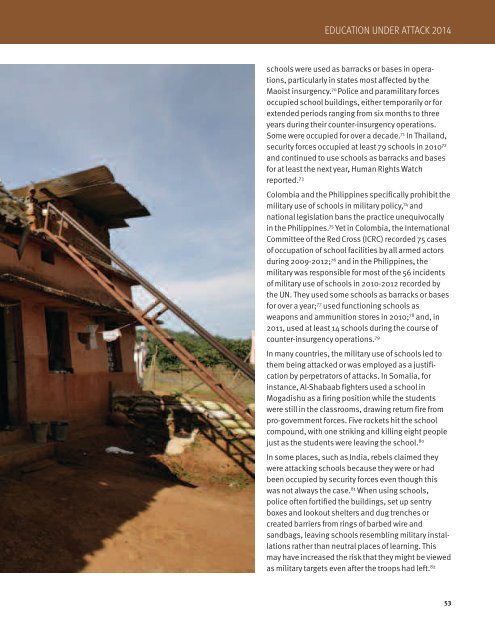You also want an ePaper? Increase the reach of your titles
YUMPU automatically turns print PDFs into web optimized ePapers that Google loves.
EDUCATION UNDER ATTACK 2014<br />
schools were used as barracks or bases in operations,<br />
particularly in states most affected by the<br />
Maoist insurgency. 70 Police and paramilitary forces<br />
occupied school buildings, either temporarily or for<br />
extended periods ranging from six months to three<br />
years during their counter-insurgency operations.<br />
Some were occupied for over a decade. 71 In Thailand,<br />
security forces occupied at least 79 schools in 2010 72<br />
and continued to use schools as barracks and bases<br />
for at least the next year, Human Rights Watch<br />
reported. 73<br />
Colombia and the Philippines specifically prohibit the<br />
military use of schools in military policy, 74 and<br />
national legislation bans the practice unequivocally<br />
in the Philippines. 75 Yet in Colombia, the International<br />
Committee of the Red Cross (ICRC) recorded 75 cases<br />
of occupation of school facilities by all armed actors<br />
during 2009-2012; 76 and in the Philippines, the<br />
military was responsible for most of the 56 incidents<br />
of military use of schools in 2010-2012 recorded by<br />
the UN. They used some schools as barracks or bases<br />
for over a year; 77 used functioning schools as<br />
weapons and ammunition stores in 2010; 78 and, in<br />
2011, used at least 14 schools during the course of<br />
counter-insurgency operations. 79<br />
In many countries, the military use of schools led to<br />
them being attacked or was employed as a justification<br />
by perpetrators of attacks. In Somalia, for<br />
instance, Al-Shabaab fighters used a school in<br />
Mogadishu as a firing position while the students<br />
were still in the classrooms, drawing return fire from<br />
pro-government forces. Five rockets hit the school<br />
compound, with one striking and killing eight people<br />
just as the students were leaving the school. 80<br />
In some places, such as India, rebels claimed they<br />
were attacking schools because they were or had<br />
been occupied by security forces even though this<br />
was not always the case. 81 When using schools,<br />
police often fortified the buildings, set up sentry<br />
boxes and lookout shelters and dug trenches or<br />
created barriers from rings of barbed wire and<br />
sandbags, leaving schools resembling military installations<br />
rather than neutral places of learning. This<br />
may have increased the risk that they might be viewed<br />
as military targets even after the troops had left. 82<br />
53


